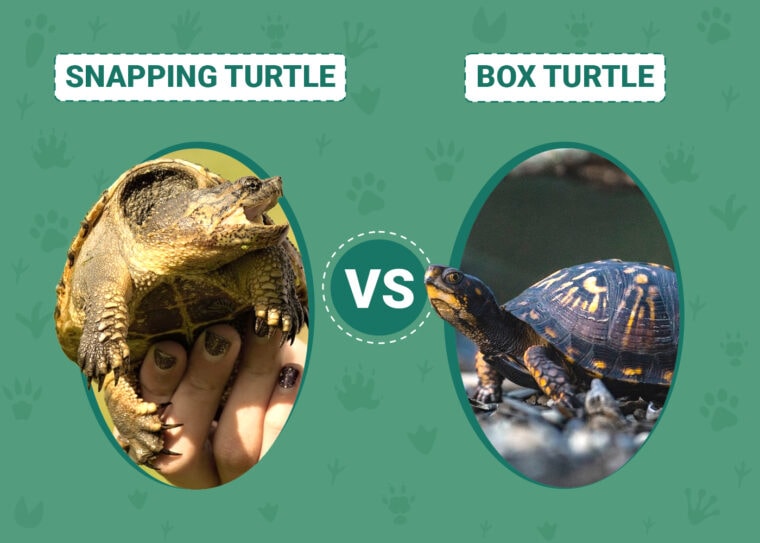
Many people mistakenly think that a turtle is a turtle, but there are actually many different species of turtles in the world — 356, to be exact.
Two of the most prominent members of the turtle family are box and snapping turtles. These two are actually quite different in many ways, and if you’re thinking about adding one to your family, you should learn as much as you can about both of them so you can decide which will be the better fit.
Below, we’ll walk you through everything you need to know about both turtles, allowing you to make the right choice for your needs.
Visual Differences

At a Glance
Snapping Turtle Overview

Most snapping turtles that are kept as pets were caught in the wild and brought home by brave (or foolish) souls. However, these animals have legal protection in some areas, so check your local laws before bringing one home.
Regardless of how you plan to acquire one, keeping a snapping turtle is a bad idea for inexperienced owners. These turtles have bristly personalities, and they can do quite a bit of damage with a bite if provoked.
Personality / Character
Snapping turtles are wild animals, even if they’ve been bred under human care. Don’t expect them to take a shine to you, regardless of how much time you spend with them. They’re actually fairly laidback in the wild, but being stuck in an enclosure and interacting with humans regularly can make them quite surly indeed.
They don’t care for being handled, so keep it to a minimum. They also have a ferocious way of letting you know that they’re done playing around, so be careful. There’s a great deal of misinformation out there about a snapping turtle’s bite (they can’t chomp off fingers or break broom handles, for example), but they can still cause deep, painful lacerations.
Don’t attempt to handle a snapping turtle without first getting instruction from a knowledgeable keeper. Failure to do this will likely end in either you or the turtle being seriously injured.
None of this is to say that owning a snapping turtle is impossible. It’s just a bad idea for novice turtle owners. Even if you are experienced, there are other turtle species out there (like, say, box turtles) that are much easier to care for.
Then again, those other turtles don’t have the same cachet that snapping turtles do, so it’s understandable if you’re willing to risk a few bites in order to have an interesting pet.
Health & Care
Snapping turtles are larger than most turtle species that are commonly kept as a pet, so you’ll need a huge tank to keep them in. Many people keep them in a kid’s pool for this reason, although you’ll still need to decorate it with rocks, plants, and a ramp that they can use to get in and out of the water.
You’ll need to keep their water between 75°F and 86°F and change at least half the water a couple times per week. You’ll also need to figure out a way to keep the water clean and provide them with a full-spectrum reptile light.
Be sure to keep their habitat as clean as you can, as they can grow ill living in poorly maintained conditions. Most snapping turtle illnesses are due to either ill-kept surroundings or poor diet, so start there if your turtle looks sick.

Snapping turtles are omnivores, and you can find a variety of foods for them at your local pet store. They often eat bloodworms, fish, shrimp, and specially-made turtle flakes. You can also give them fruit as a snack occasionally.
Use their appearance to guide your feeding choices. If they look like they’re getting too big for their shell, cut back on their rations, but if their skin starts to sag, feed them more. As a general rule of thumb, though, feed full-grown turtles around three times per week.
Suitability
Snapping turtles are a truly exotic pet, but as such, they’re only suitable for experienced turtle owners. They can be quite dangerous, as their powerful beaks are capable of creating deep lacerations if they happen to bite you.
Bites are also surprisingly hard to avoid if you don’t know how to handle these turtles. You should never let a child play with a snapping turtle, nor should you pick one up if you can possibly avoid it.
If you have the know-how necessary to care for one, a snapping turtle can be a fun yet challenging pet to own. For everyone else, though, they should just be an animal that you hope to avoid while swimming.
Box Turtle Overview

Box turtles are much more commonly owned than snapping turtles, and for good reason: They’re naturally charismatic animals that make wonderful pets.
They’re also much easier to acquire, as they’re often sold in stores or by breeders, and you can often find them wandering around in the wild. Even if you bring home a box turtle that you caught yourself, they can often take well to being pets and learn to tolerate being handled by humans, even if they never truly enjoy it.
Personality / Character
Box turtle aficionados will tell you that each individual turtle has a distinct personality, and there’s a great deal of truth to that. While their particular quirks won’t be as pronounced as a dog’s or cat’s might be, they still have their own unique disposition.
They can learn to recognize their owners by both sight and appearance, and many box turtle keepers say that they “beg” just like other pets. They do this by raising their heads and opening and closing their mouths whenever they notice their favorite person approaching.
To get them accustomed to you, you need to gently handle them and have other interactions with them as often as possible. However, pay close attention to their behavior, as any signs of stress will indicate that they’re being over-handled, completely defeating the purpose of the interaction.
Box turtles can be both fearful and aggressive, depending on the individual, and they may lash out or retreat when frightened. Each individual is capable of both behaviors at different times, of course, but they’ll be more likely to choose one course of action over another based on their personality.
They tend to be naturally inquisitive as well, so if they don’t seem curious about their surroundings, it’s a sign of stress.

Health & Care
Unlike many turtles, box turtles are largely terrestrial creatures, so you won’t have to keep them in water. Like snapping turtles, though, they thrive in outdoor enclosures, especially if your habitat mimics their natural surroundings.
If you create an enclosure for them, make sure they have areas in which they can both bask in the sun and get out of it as needed. Be careful about what you put in there, as they’ll likely eat any plants or insects that wander in. Make sure the plants are safe and free of chemicals or pesticides (there may not be much you can do about the insects).
While they don’t live in water, they need plenty of it. Keep a shallow pan handy for them to drink out of and bask in as they see fit. Replace the water every day to prevent harmful bacteria from growing inside it.
They also need a place to burrow. Keep loose litter or other substrate handy, and keep it in sufficient quantities that they can completely submerge themselves in it. You should also remove soiled litter as often as possible (at least weekly).
You’ll need to keep their surroundings fairly humid, so if you live in a dry climate, you’ll need to mist them every day.
Suitability
Box turtles are some of the easiest pets to keep, especially among turtles. They can be suitable for small children, but keep in mind that they often live for 30 years or more, so owning one can’t be a passing fad.
If you’re just getting started with turtle ownership, the box turtle is likely the best way to get your feet wet. They’re much more agreeable than snapping turtles and easier to own in general. If your ultimate goal is to have a snapping turtle, the box turtle should be your gateway pet.
Which Turtle Is Right for You?
The fact of the matter is that snapping turtles are incredibly challenging (and potentially illegal) to own. If you aren’t extremely confident in your turtle ownership skills, then you have no business bringing one into your home.
Box turtles, on the other hand, are complete sweethearts by comparison. They’re much easier to own and much less likely to significantly injure you. They’re suitable for everyone, from kids to adults, and they require little in the way of specialized knowledge.
If you’re ready to own a snapping turtle, you’ll know. If you’re not sure, then it means you’re better off sticking with a box turtle instead.
See Also:
- German Shorthaired Pointer vs Weimaraner: Differences Explained (With Pictures)
- Vizsla vs Weimaraner: Key Differences (With Pictures)
Featured Image: Top – terski, Pixabay | Bottom – ReedleyMom, Pixabay











